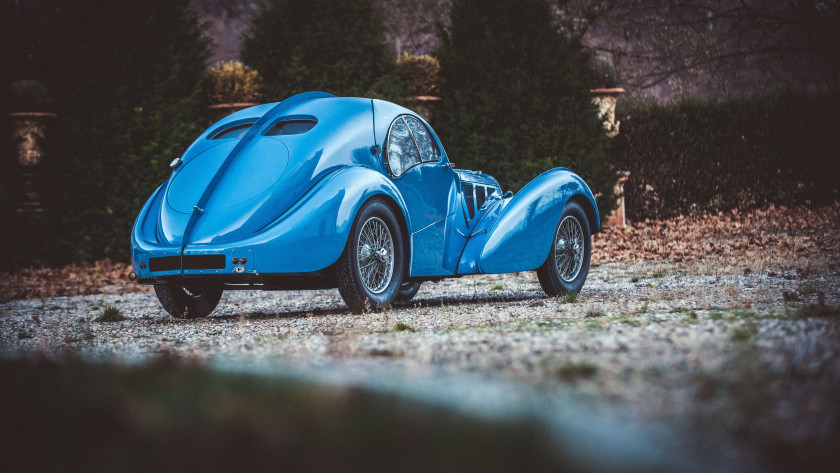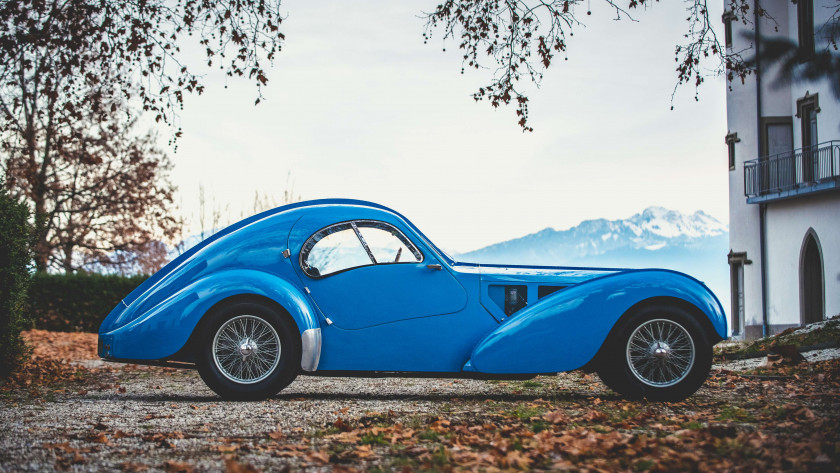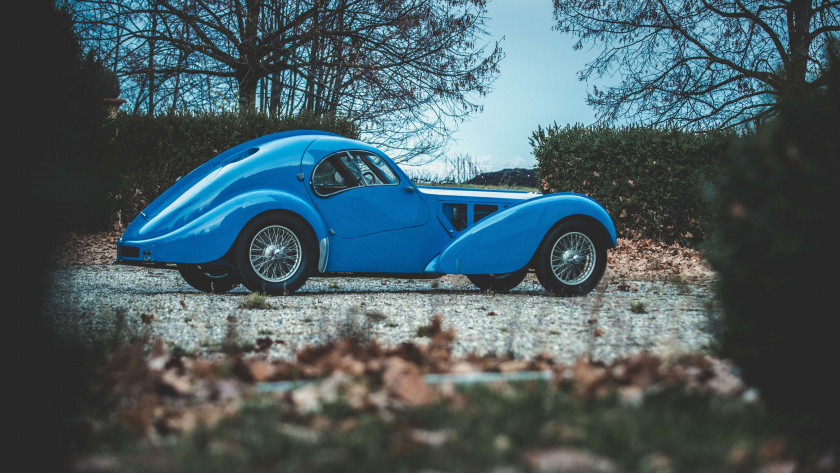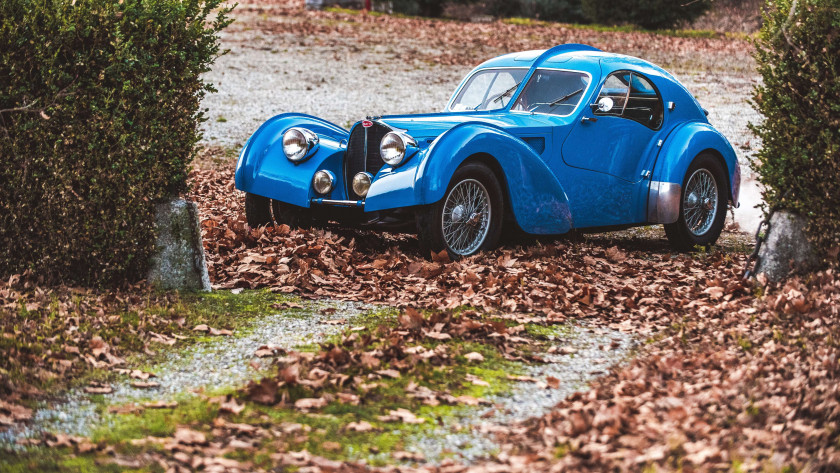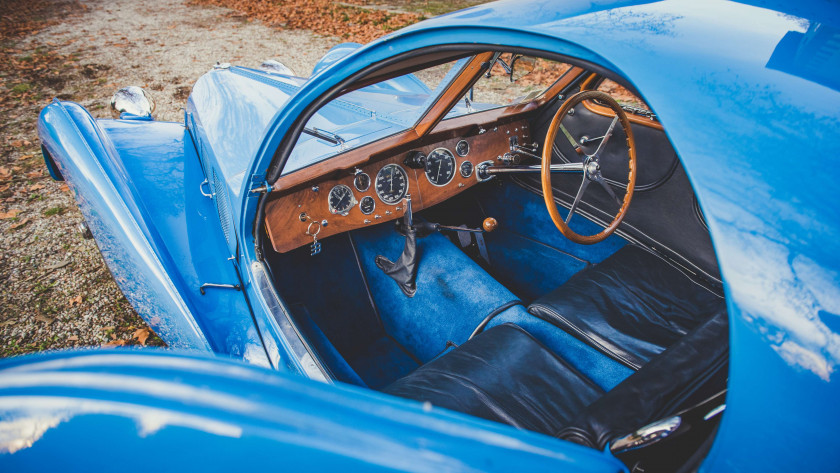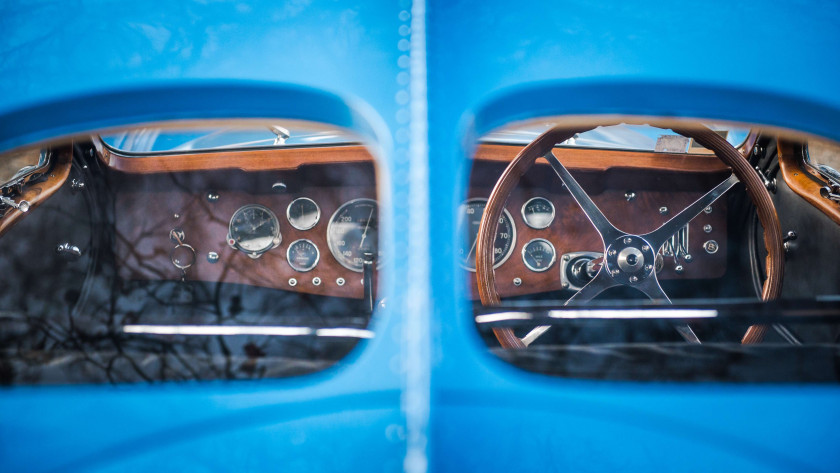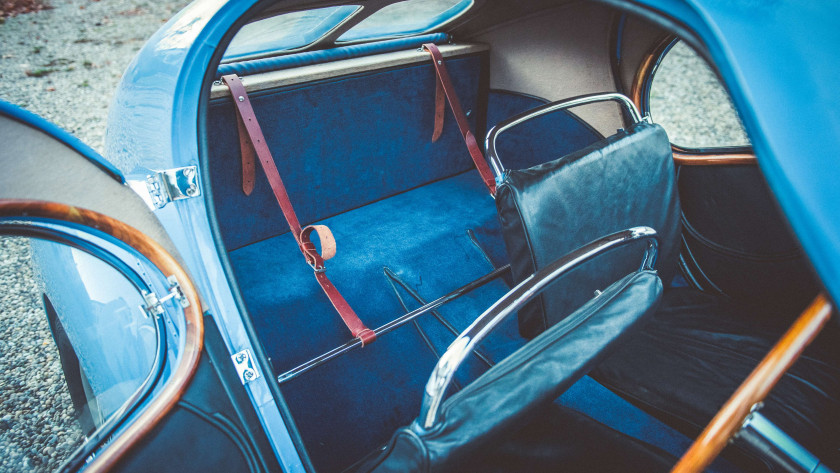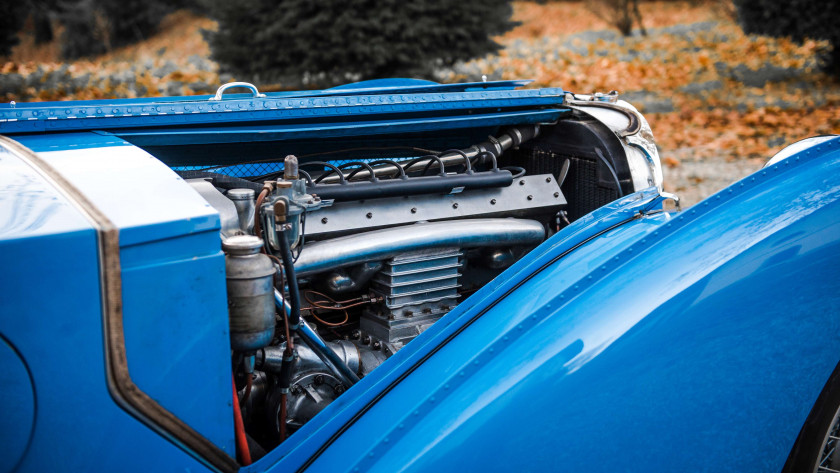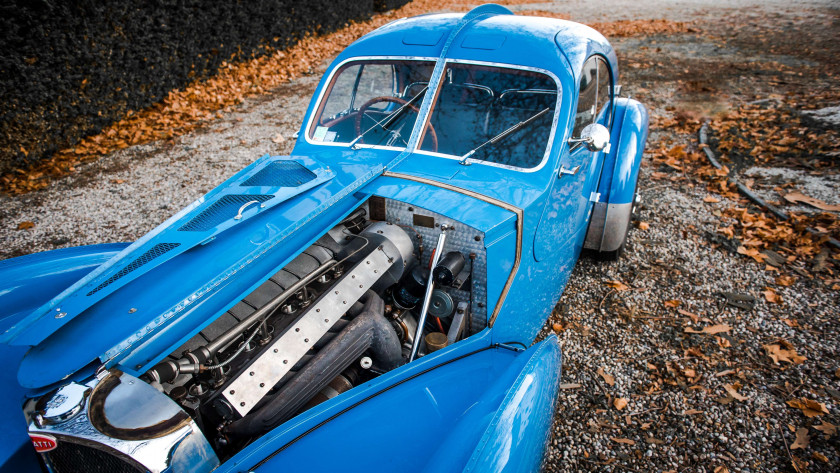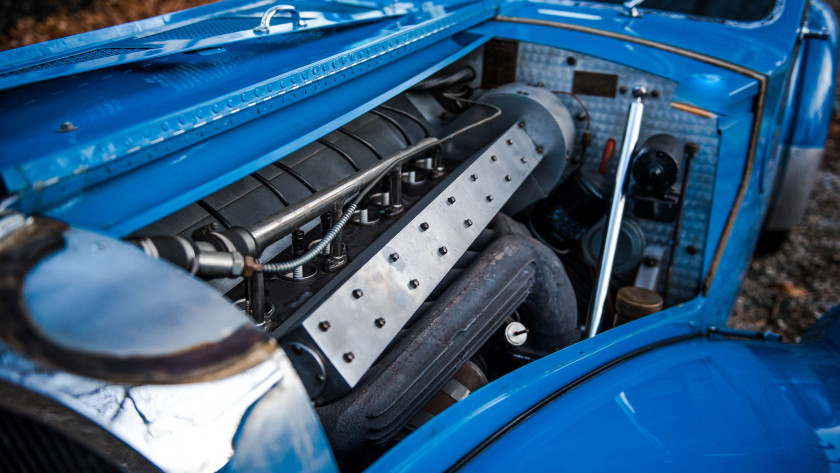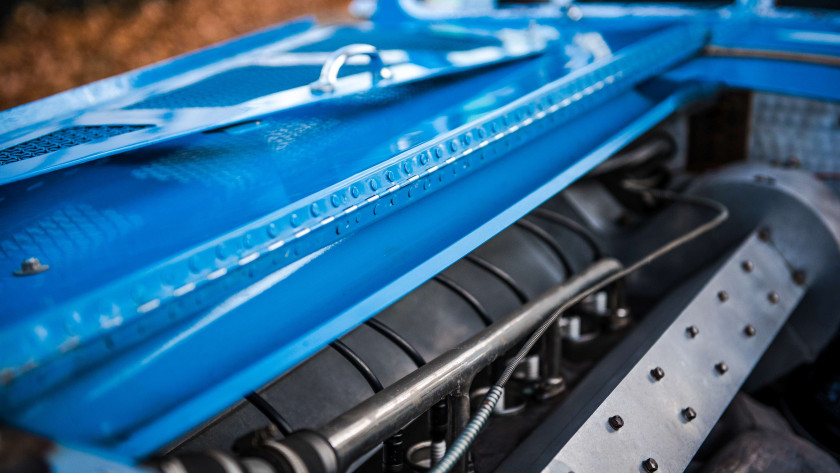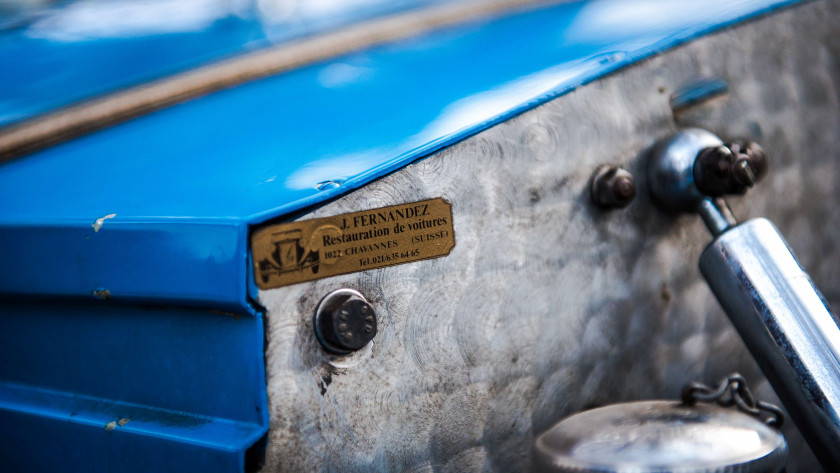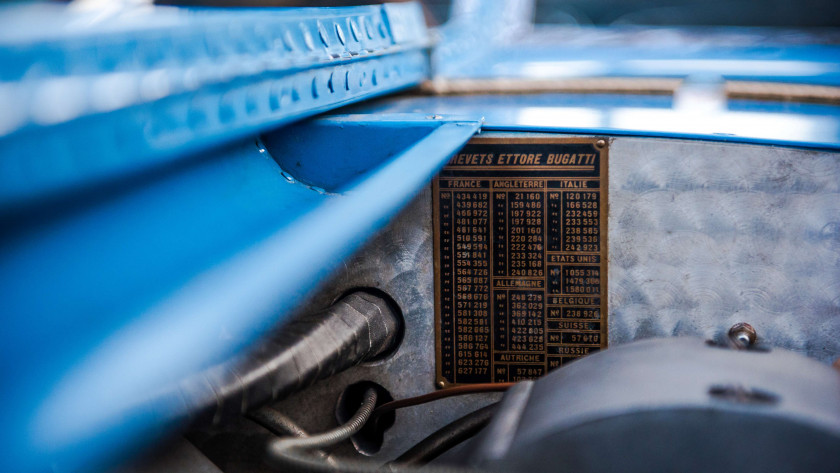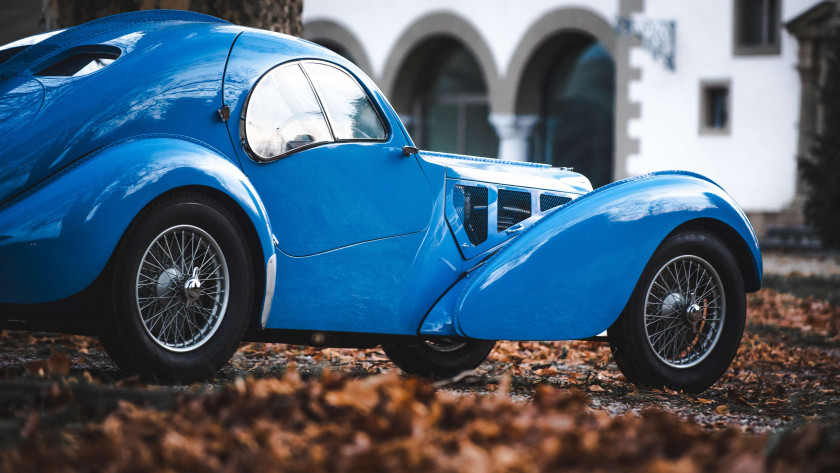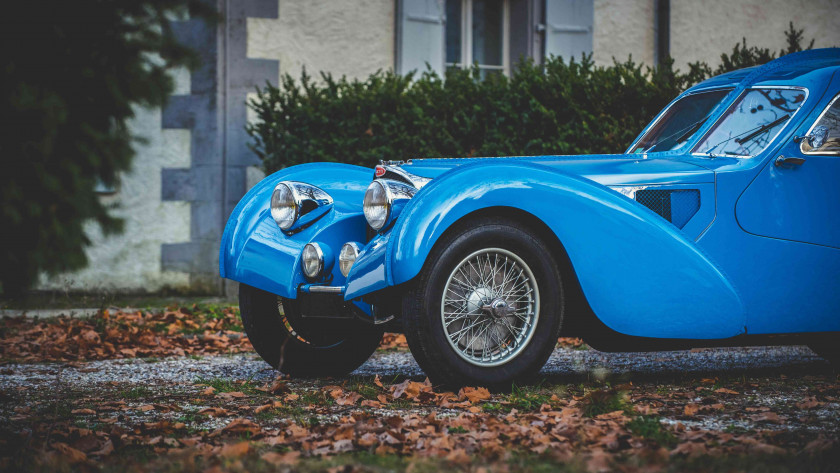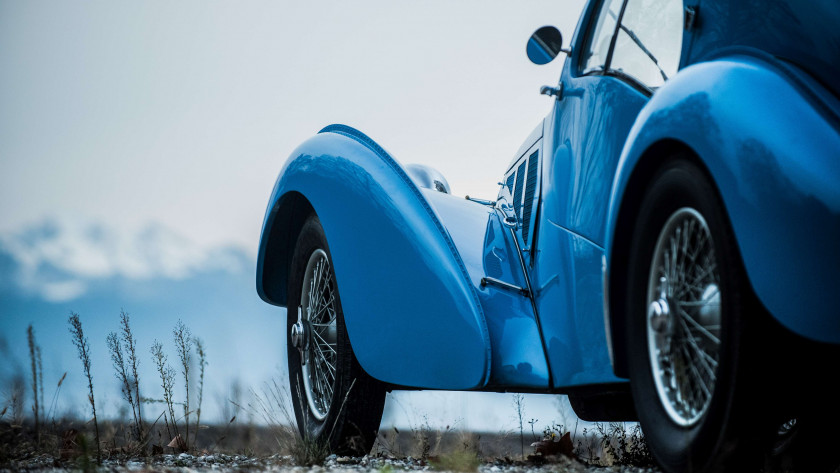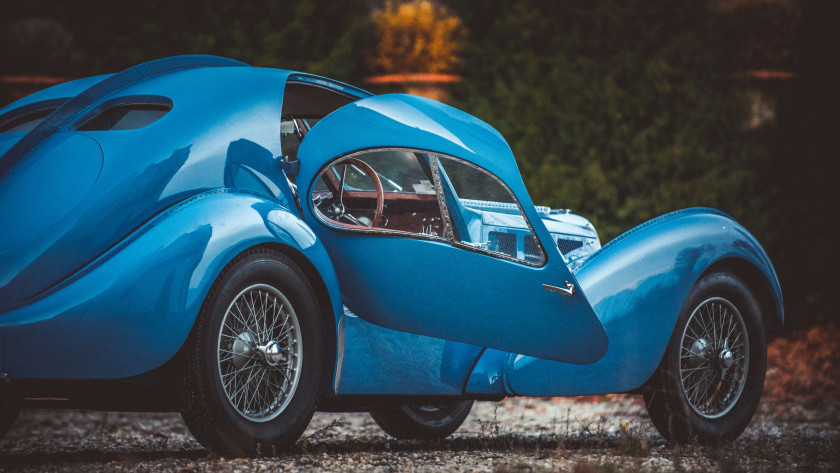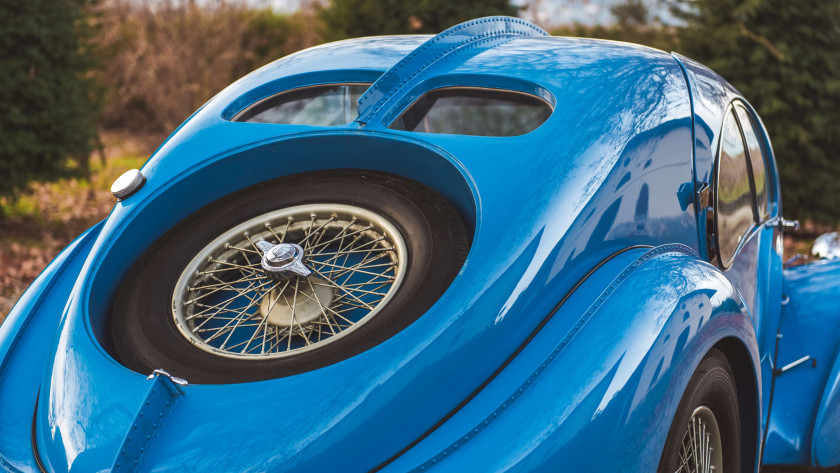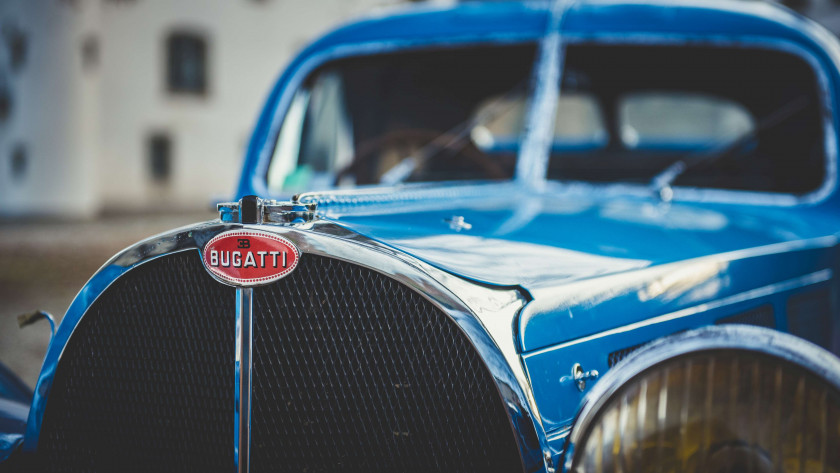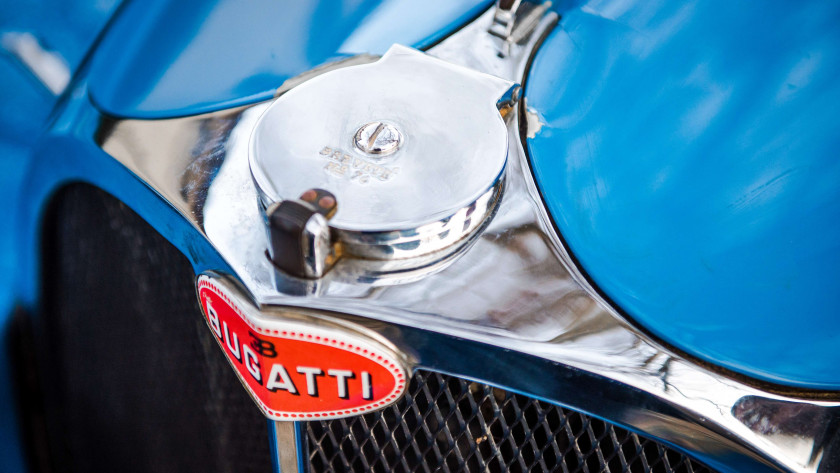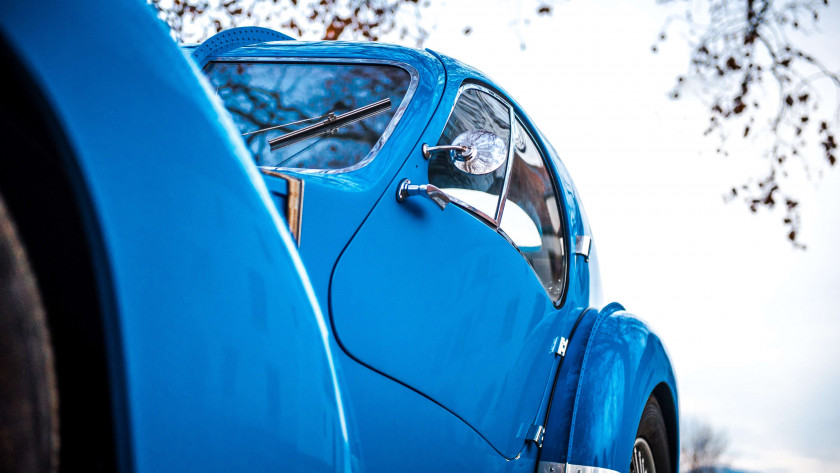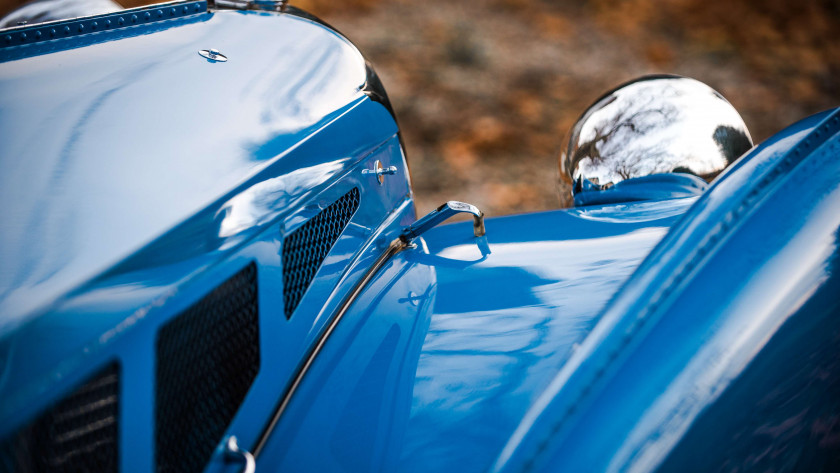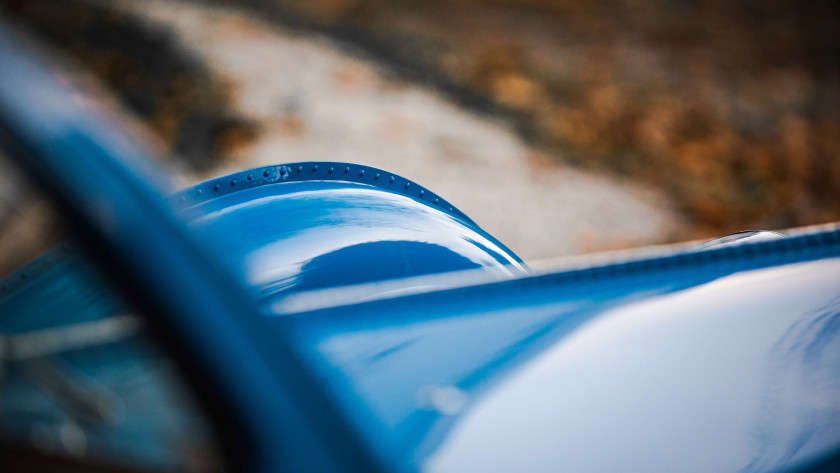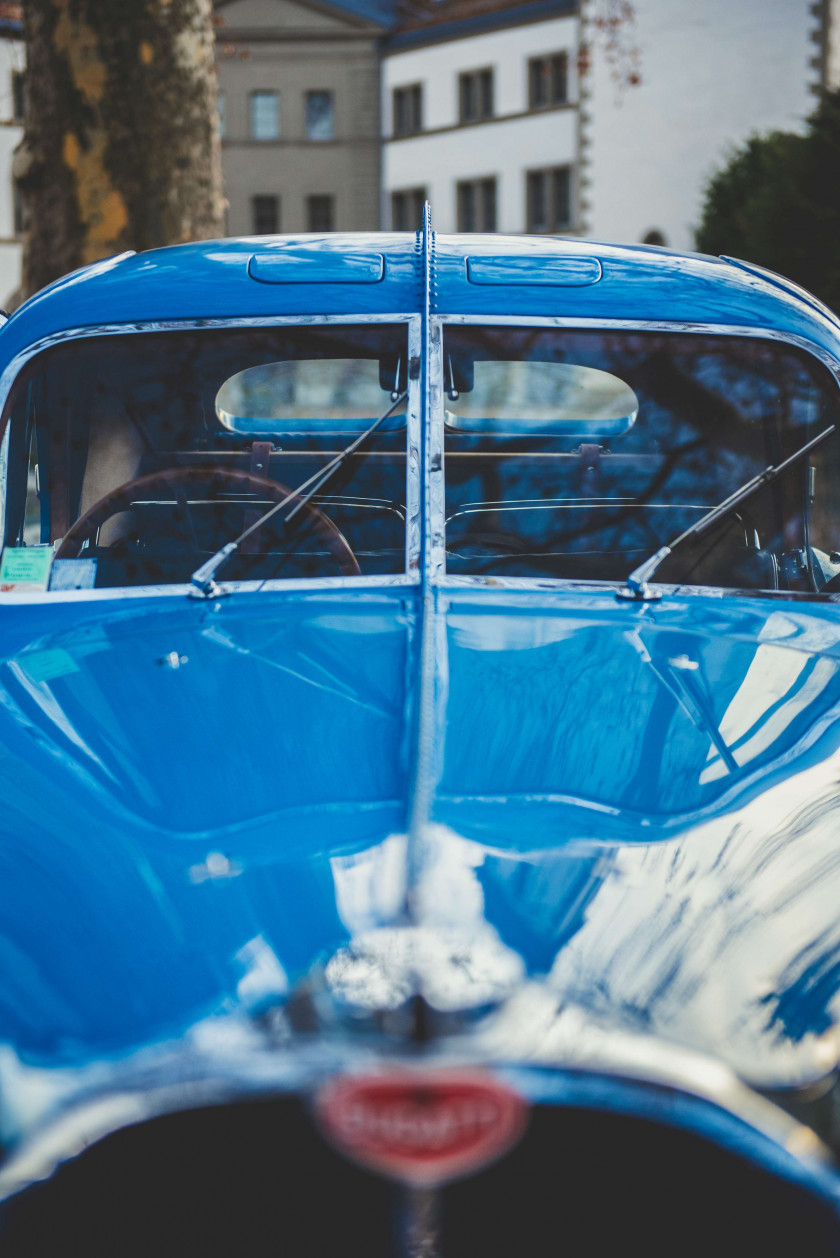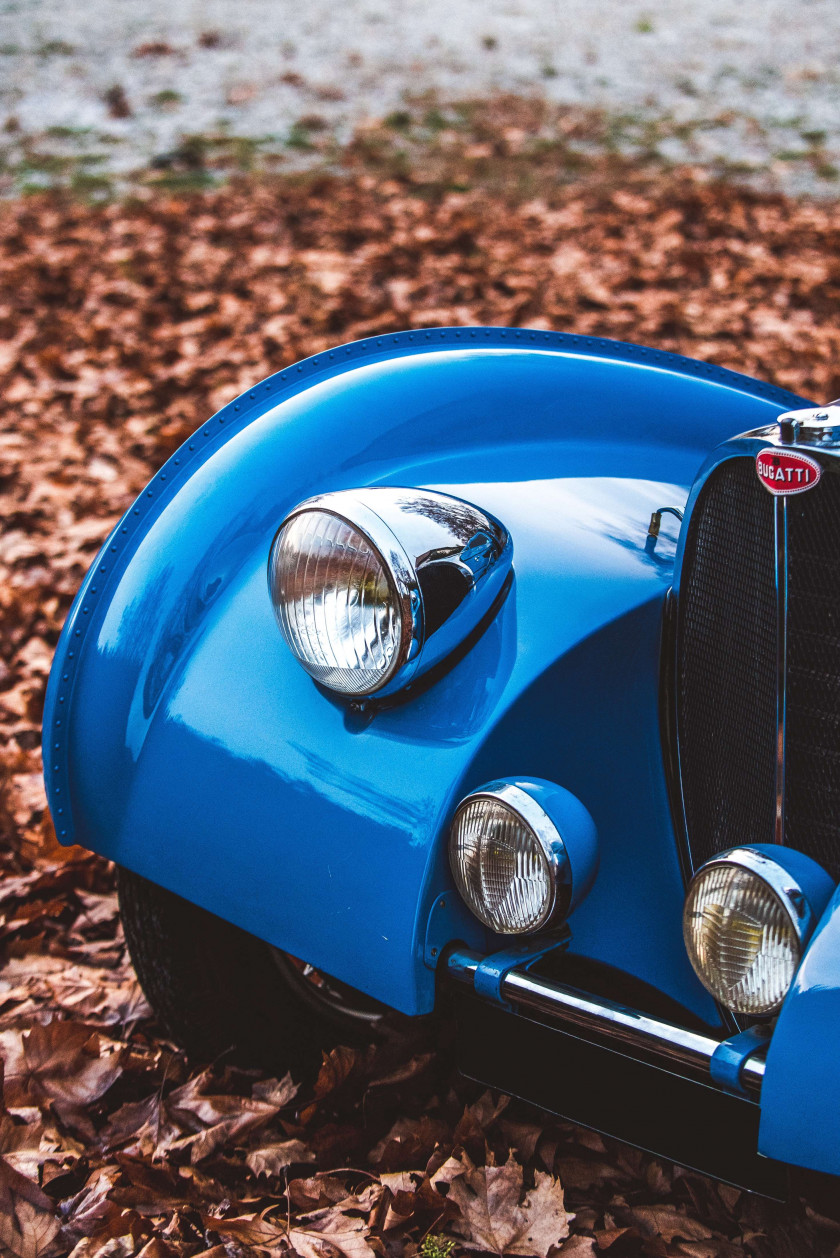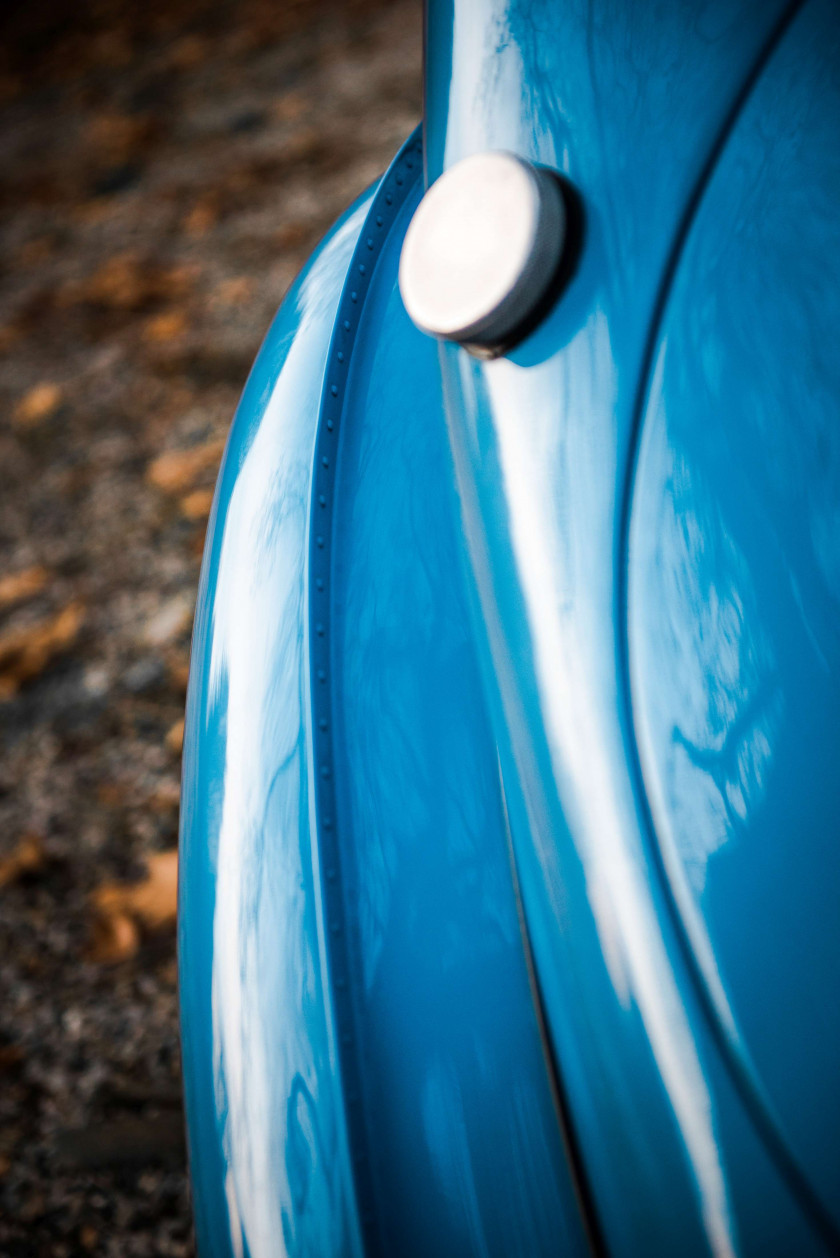Sale Rétromobile 2019 The Official Sale - 08 february 2019 /Lot 39 1936 Bugatti 57 Atlantic modifiée Erik Koux
1936 Bugatti 57 Atlantic modifiée Erik Koux
Carte grise française
Châssis n° 57654
Boîte à cames n° 9G (gauche) et 28D (droite)
Boite n° 256 avec couvercle n° 219
Pont n° 335
- Projet à partir d'une Bugatti 57
- Réalisation de très haut niveau
- Carrosserie en aluminium
- La plus belle réalisation d'Erik Koux avec carrosserie aluminium
- État superbe
Aujourd'hui, les Bugatti Atlantic authentiques sont entre les mains de collectionneurs qui ne souhaitent pas s'en défaire, et elles font partie des automobiles les plus chères du monde. Par conséquent, l'amateur souhaitant profiter de cette création fabuleuse de Jean Bugatti, sur la base du brillant châssis 57 S, n'a pas d'autre choix que de se tourner vers une reconstruction où le meilleur côtoie le pire. Ici, nous avons le plaisir de proposer une des plus belles et des plus fidèles répliques de Bugatti Atlantic existantes. Elle a en effet l'avantage de s'appuyer sur une authentique Bugatti 57 (châssis n°57654), carrossée en berline 57 par Gangloff. Elle était assez complète selon les souvenirs de Hans Matti, spécialiste suisse de la marque. En 1954, cette voiture était immatriculée à Paris, puis elle a été achetée vers 1986 par un important collectionneur français ayant possédé une douzaine de Bugatti. A l'époque toutefois, la 57 quatre portes ne le satisfaisait pas et il ne la considérait que comme une base car il rêvait du nec plus ultra en matière de Bugatti, une Atlantic.
Il se trouve qu'à la même époque, un ingénieur danois du nom d'Erik Koux vivant dans le sud de la France, commençait à réfléchir à la réalisation de répliques de Bugatti Atlantic. Véritable passionné de la marque et génie créatif, Erik Koux va se lancer dans l'entreprise folle de reconstruire cette voiture mythique. En 1989, les deux hommes commencent un échange de correspondance pour initier le projet de fabriquer, sur la base de la 57 654, une Atlantic la plus proche possible de l'originale.
En novembre 1991, la voiture est acheminée en châssis dans l'atelier d'Erik Koux, pour commencer la transformation. Les différences entre une 57 et une 57 S Atlantic se concentrent principalement au niveau du moteur (à carter sec pour la 57 S), du châssis (plus bas pour la 57 S) et bien sûr de la carrosserie. Par conséquent, Koux fournit un châssis de type 57 S de sa fabrication, ainsi qu'un carter moteur réalisé spécialement, l'élément d'origine étant introuvable. Il l'adapte en utilisant les boîtes à came reprises sur la 57 654, numéro 9 G (gauche) et 28D (droite). L'ensemble moteur-boîte passera ensuite entre les mains de Laurent Rondoni, le spécialiste mondialement reconnu de Ventoux Moteurs, à Carpentras, pour une remise en état complète.
La voiture arrive ensuite en 1993 dans les ateliers Fernandez, basés à Lausanne, un des plus réputés de Suisse pour la réalisation de la carrosserie. Ce spécialiste a travaillé sur des projets fantastiques tels la remise en état d'une carrosserie Talbot "Goutte d'eau" ayant remporté le concours d'élégance de Pebble Beach ainsi que la réalisation, en 1992, d'une première Bugatti Atlantic par Koux en Aluminium pour un important collectionneur hollandais (57302). Il a donc déjà pu approfondir sa connaissance du modèle et dans ce but, les cotes et plans détaillés de la carrosserie ont été fournis par Erik Koux à partir de la voiture d'origine. Il fait construire ainsi entièrement la structure en bois de la voiture par l'ébénisterie G.Clavel avant de réaliser une carrosserie en aluminium magistralement réussie. Une fois achevée, la carrosserie a été envoyée à l'atelier Margairaz, de Lausanne, pour peinture. Terminée en 1995, la voiture a été peaufinée chez Fernandez et Guifrida avant de passer avec succès en 1996 le contrôle technique, et, d'être immatriculée en France.
Cette voiture, tout à fait atypique, est accompagnée d'un volumineux dossier qui en retrace la gestation et la réalisation, avec une abondante correspondance avec Erik Koux et de nombreuses factures. L'intérêt de cette Atlantic est qu'elle s'appuie sur une authentique Bugatti 57 et, d'ailleurs, Hans Matti a procédé à son inspection et a noté tous les numéros relevés sur les pièces d'origine Bugatti. Depuis qu'elle est terminée, cette voiture a peu roulé et se trouve dans un état superbe.
Rappelons que l'Atlantic recevait le moteur Bugatti 3,3L double arbre 180 ch et pouvait atteindre 200 km/h, privilège extrêmement rare à une époque où les automobiles de tourisme plafonnaient à 130 km/h pour les plus brillantes. A ces performances, l'Atlantic ajoutait une forme profilée donnant l'impression d'une extraterrestre dans un paysage de voitures hautes et traditionnelles. Les réalisations d'Erik Koux étaient faites avec beaucoup de sérieux, fidélité et amour de la marque. Cette Atlantic est un hommage appuyé à ce que beaucoup considèrent comme la voiture la plus extraordinaire de tous les temps.
La participation aux enchères pour ce lot est soumise à une procédure d'enregistrement particulière. Si vous souhaitez enchérir sur ce lot, merci de vous rapprocher du bureau des enchères ou du département Motorcars minimum 48 heures avant la vente.
French title
Chassis n°57654
Camshafts n°9G (left) and 28D (right)
Transmission n°256 with cover n°219
Axle n°335
- Project from a Bugatti 57
- Very high standard production
- Aluminium bodywork
- Erik Koux's most beautiful achievement with aluminium body
- Superb condition
Authentic Bugatti Atlantic cars are nowadays in possession of collectors who are not willing to be separated from them and they are among the most expensive automobiles in the world. Therefore, the enthusiast wishing to enjoy this fabulous creation from Jean Bugatti (based on the brilliant chassis 57S) had no choice but to turn to a recreation where the best mixed with the worst. In this case, we are delighted to offer one of the most beautiful and accurate Bugatti Atlantic replicas still in existence. It has indeed the particularity of relying on an authentic Bugatti 57 (chassis No 57654) with its saloon 57 bodywork done by Gangloff; it was also pretty complete from what recalls Hans Matti, a swiss specialist of the brand. This car was registered in Paris in 1954, it was then purchased around 1986 by a serious French collector who owned a dozen Bugatti automobiles. During that period however, he was not satisfied with the four-door 57 and considered it only as a base, since he was dreaming of the ultimate when it comes to Bugatti: the Atlantic.
It turns out that during the same period, a Danish engineer living in the South of France named Erik Koux began to think about making Bugatti Atlantic replicas. As a true lover of the brand and a creative genius, Erik Koux would embark himself into this crazy venture of rebuilding this mythical car. In 1989, both men began an exchange of correspondence in order to initiate a project to build an Atlantic as close as possible to the original, based on a 57 654 version. In November 1991, the chassis of the car is shipped to Erik Koux's workshop in order to start its transformation. Differences between a 57 and a 57S are mainly concentrated around the engine (dry crankcase for the 57 S), the chassis (lower for the 57 S) and of course the bodywork. Consequently, Koux provided a 57S type chassis from his factory, as well as the engine crankcase which was especially made since the original part was untraceable. He customised it using the camshafts from the 57 654, number 9G (left) and 28D (right). The engine-transmission assembly was then handed over for a complete restoration to Laurent Rondoni, the world renowned specialist from Ventoux Moteurs in Carpentras.
The car is then transported to Lausanne at the Fernandez workshop in 1993, one of the most reputable swiss experts when it comes to bodywork development. This specialist has worked on fantastic projects, such as the bodywork restoration of a Talbot "Teardrop" which won the Pebble Beach concours d'elegance and, also the realisation of its first aluminium Bugatti Atlantic by Koux in 1992 for an important Dutch collector (57302). They consequently gained a deeper knowledge of this model and on that basis, all detailed dimensions and plans of the bodywork were provided to them by Erik Koux (from the original car). That's how they ask to Ebenisterie G.Clavel to built the entire wooden structure before converting it into a brilliant and successful aluminium body. Once finished, the bodywork is then sent for painting at the Margairaz workshop based around the same town in Lausanne. The car is finally polished and completed at Guifrida and Fernandez in 1995, before successfully passing its technical tests and getting registered for the road in France in 1996. This unconventional car goes hand in hand with a large folder which allows to track its elaboration and fabrication, with tons of correspondence with Erik Koux and numerous invoices. One of the things to remember is that this Atlantic is very much based on an authentic Bugatti 57; Hans Matti, who conducted his inspection, consequently identified all the numbers taken from original Bugatti parts. This car has rarely been on the road since its completion and remains in superb condition today.
Let's not forget that the Atlantic had a 180 hp Bugatti 3.3 litres dual-camshafts engine which could reach 200km/h, an extremely rare privilege at a time when even the most amazing touring automobiles could reach up to 130km/h only. With this kind of performance, the Atlantic was in a league of its own, consequently being perceived as an extraterrestrial machine in a world of high and traditional cars. Erik Koux's achievements were made with great seriousness, loyalty and love of the brand. This Atlantic is a tribute to what many consider to be the most extraordinary car of all time.
Participating in the auction on this lot is subject to a special registration process. If you would like to bid on this lot, please get in touch with the bidding office or the motorcars department at least 48 hours before the sale.
Photos © Loïc Kernen
Estimation 800 000 - 1 200 000 €
Sold 852,936 €
* Results are displayed including buyer’s fees and taxes. They are generated automatically and can be modified.
Carte grise française
Châssis n° 57654
Boîte à cames n° 9G (gauche) et 28D (droite)
Boite n° 256 avec couvercle n° 219
Pont n° 335
- Projet à partir d'une Bugatti 57
- Réalisation de très haut niveau
- Carrosserie en aluminium
- La plus belle réalisation d'Erik Koux avec carrosserie aluminium
- État superbe
Aujourd'hui, les Bugatti Atlantic authentiques sont entre les mains de collectionneurs qui ne souhaitent pas s'en défaire, et elles font partie des automobiles les plus chères du monde. Par conséquent, l'amateur souhaitant profiter de cette création fabuleuse de Jean Bugatti, sur la base du brillant châssis 57 S, n'a pas d'autre choix que de se tourner vers une reconstruction où le meilleur côtoie le pire. Ici, nous avons le plaisir de proposer une des plus belles et des plus fidèles répliques de Bugatti Atlantic existantes. Elle a en effet l'avantage de s'appuyer sur une authentique Bugatti 57 (châssis n°57654), carrossée en berline 57 par Gangloff. Elle était assez complète selon les souvenirs de Hans Matti, spécialiste suisse de la marque. En 1954, cette voiture était immatriculée à Paris, puis elle a été achetée vers 1986 par un important collectionneur français ayant possédé une douzaine de Bugatti. A l'époque toutefois, la 57 quatre portes ne le satisfaisait pas et il ne la considérait que comme une base car il rêvait du nec plus ultra en matière de Bugatti, une Atlantic.
Il se trouve qu'à la même époque, un ingénieur danois du nom d'Erik Koux vivant dans le sud de la France, commençait à réfléchir à la réalisation de répliques de Bugatti Atlantic. Véritable passionné de la marque et génie créatif, Erik Koux va se lancer dans l'entreprise folle de reconstruire cette voiture mythique. En 1989, les deux hommes commencent un échange de correspondance pour initier le projet de fabriquer, sur la base de la 57 654, une Atlantic la plus proche possible de l'originale.
En novembre 1991, la voiture est acheminée en châssis dans l'atelier d'Erik Koux, pour commencer la transformation. Les différences entre une 57 et une 57 S Atlantic se concentrent principalement au niveau du moteur (à carter sec pour la 57 S), du châssis (plus bas pour la 57 S) et bien sûr de la carrosserie. Par conséquent, Koux fournit un châssis de type 57 S de sa fabrication, ainsi qu'un carter moteur réalisé spécialement, l'élément d'origine étant introuvable. Il l'adapte en utilisant les boîtes à came reprises sur la 57 654, numéro 9 G (gauche) et 28D (droite). L'ensemble moteur-boîte passera ensuite entre les mains de Laurent Rondoni, le spécialiste mondialement reconnu de Ventoux Moteurs, à Carpentras, pour une remise en état complète.
La voiture arrive ensuite en 1993 dans les ateliers Fernandez, basés à Lausanne, un des plus réputés de Suisse pour la réalisation de la carrosserie. Ce spécialiste a travaillé sur des projets fantastiques tels la remise en état d'une carrosserie Talbot "Goutte d'eau" ayant remporté le concours d'élégance de Pebble Beach ainsi que la réalisation, en 1992, d'une première Bugatti Atlantic par Koux en Aluminium pour un important collectionneur hollandais (57302). Il a donc déjà pu approfondir sa connaissance du modèle et dans ce but, les cotes et plans détaillés de la carrosserie ont été fournis par Erik Koux à partir de la voiture d'origine. Il fait construire ainsi entièrement la structure en bois de la voiture par l'ébénisterie G.Clavel avant de réaliser une carrosserie en aluminium magistralement réussie. Une fois achevée, la carrosserie a été envoyée à l'atelier Margairaz, de Lausanne, pour peinture. Terminée en 1995, la voiture a été peaufinée chez Fernandez et Guifrida avant de passer avec succès en 1996 le contrôle technique, et, d'être immatriculée en France.
Cette voiture, tout à fait atypique, est accompagnée d'un volumineux dossier qui en retrace la gestation et la réalisation, avec une abondante correspondance avec Erik Koux et de nombreuses factures. L'intérêt de cette Atlantic est qu'elle s'appuie sur une authentique Bugatti 57 et, d'ailleurs, Hans Matti a procédé à son inspection et a noté tous les numéros relevés sur les pièces d'origine Bugatti. Depuis qu'elle est terminée, cette voiture a peu roulé et se trouve dans un état superbe.
Rappelons que l'Atlantic recevait le moteur Bugatti 3,3L double arbre 180 ch et pouvait atteindre 200 km/h, privilège extrêmement rare à une époque où les automobiles de tourisme plafonnaient à 130 km/h pour les plus brillantes. A ces performances, l'Atlantic ajoutait une forme profilée donnant l'impression d'une extraterrestre dans un paysage de voitures hautes et traditionnelles. Les réalisations d'Erik Koux étaient faites avec beaucoup de sérieux, fidélité et amour de la marque. Cette Atlantic est un hommage appuyé à ce que beaucoup considèrent comme la voiture la plus extraordinaire de tous les temps.
La participation aux enchères pour ce lot est soumise à une procédure d'enregistrement particulière. Si vous souhaitez enchérir sur ce lot, merci de vous rapprocher du bureau des enchères ou du département Motorcars minimum 48 heures avant la vente.
French title
Chassis n°57654
Camshafts n°9G (left) and 28D (right)
Transmission n°256 with cover n°219
Axle n°335
- Project from a Bugatti 57
- Very high standard production
- Aluminium bodywork
- Erik Koux's most beautiful achievement with aluminium body
- Superb condition
Authentic Bugatti Atlantic cars are nowadays in possession of collectors who are not willing to be separated from them and they are among the most expensive automobiles in the world. Therefore, the enthusiast wishing to enjoy this fabulous creation from Jean Bugatti (based on the brilliant chassis 57S) had no choice but to turn to a recreation where the best mixed with the worst. In this case, we are delighted to offer one of the most beautiful and accurate Bugatti Atlantic replicas still in existence. It has indeed the particularity of relying on an authentic Bugatti 57 (chassis No 57654) with its saloon 57 bodywork done by Gangloff; it was also pretty complete from what recalls Hans Matti, a swiss specialist of the brand. This car was registered in Paris in 1954, it was then purchased around 1986 by a serious French collector who owned a dozen Bugatti automobiles. During that period however, he was not satisfied with the four-door 57 and considered it only as a base, since he was dreaming of the ultimate when it comes to Bugatti: the Atlantic.
It turns out that during the same period, a Danish engineer living in the South of France named Erik Koux began to think about making Bugatti Atlantic replicas. As a true lover of the brand and a creative genius, Erik Koux would embark himself into this crazy venture of rebuilding this mythical car. In 1989, both men began an exchange of correspondence in order to initiate a project to build an Atlantic as close as possible to the original, based on a 57 654 version. In November 1991, the chassis of the car is shipped to Erik Koux's workshop in order to start its transformation. Differences between a 57 and a 57S are mainly concentrated around the engine (dry crankcase for the 57 S), the chassis (lower for the 57 S) and of course the bodywork. Consequently, Koux provided a 57S type chassis from his factory, as well as the engine crankcase which was especially made since the original part was untraceable. He customised it using the camshafts from the 57 654, number 9G (left) and 28D (right). The engine-transmission assembly was then handed over for a complete restoration to Laurent Rondoni, the world renowned specialist from Ventoux Moteurs in Carpentras.
The car is then transported to Lausanne at the Fernandez workshop in 1993, one of the most reputable swiss experts when it comes to bodywork development. This specialist has worked on fantastic projects, such as the bodywork restoration of a Talbot "Teardrop" which won the Pebble Beach concours d'elegance and, also the realisation of its first aluminium Bugatti Atlantic by Koux in 1992 for an important Dutch collector (57302). They consequently gained a deeper knowledge of this model and on that basis, all detailed dimensions and plans of the bodywork were provided to them by Erik Koux (from the original car). That's how they ask to Ebenisterie G.Clavel to built the entire wooden structure before converting it into a brilliant and successful aluminium body. Once finished, the bodywork is then sent for painting at the Margairaz workshop based around the same town in Lausanne. The car is finally polished and completed at Guifrida and Fernandez in 1995, before successfully passing its technical tests and getting registered for the road in France in 1996. This unconventional car goes hand in hand with a large folder which allows to track its elaboration and fabrication, with tons of correspondence with Erik Koux and numerous invoices. One of the things to remember is that this Atlantic is very much based on an authentic Bugatti 57; Hans Matti, who conducted his inspection, consequently identified all the numbers taken from original Bugatti parts. This car has rarely been on the road since its completion and remains in superb condition today.
Let's not forget that the Atlantic had a 180 hp Bugatti 3.3 litres dual-camshafts engine which could reach 200km/h, an extremely rare privilege at a time when even the most amazing touring automobiles could reach up to 130km/h only. With this kind of performance, the Atlantic was in a league of its own, consequently being perceived as an extraterrestrial machine in a world of high and traditional cars. Erik Koux's achievements were made with great seriousness, loyalty and love of the brand. This Atlantic is a tribute to what many consider to be the most extraordinary car of all time.
Participating in the auction on this lot is subject to a special registration process. If you would like to bid on this lot, please get in touch with the bidding office or the motorcars department at least 48 hours before the sale.
Photos © Loïc Kernen
Estimation 800 000 - 1 200 000 €
Sold 852,936 €
* Results are displayed including buyer’s fees and taxes. They are generated automatically and can be modified.
Lot 39
1936 Bugatti 57 Atlantic modifiée Erik Koux
Lot 39
Sold 852,936 € [$]
1936 Bugatti 57 Atlantic modifiée Erik Koux
Carte grise française
Châssis n° 57654
Boîte à cames n° 9G (gauche) et 28D (droite)
Boite n° 256 avec couvercle n° 219
Pont n° 335
- Projet à partir d'une Bugatti 57
- Réalisation de très haut niveau
- Carrosserie en aluminium
- La plus belle réalisation d'Erik Koux avec carrosserie aluminium
- État superbe
Aujourd'hui, les Bugatti Atlantic authentiques sont entre les mains de collectionneurs qui ne souhaitent pas s'en défaire, et elles font partie des automobiles les plus chères du monde. Par conséquent, l'amateur souhaitant profiter de cette création fabuleuse de Jean Bugatti, sur la base du brillant châssis 57 S, n'a pas d'autre choix que de se tourner vers une reconstruction où le meilleur côtoie le pire. Ici, nous avons le plaisir de proposer une des plus belles et des plus fidèles répliques de Bugatti Atlantic existantes. Elle a en effet l'avantage de s'appuyer sur une authentique Bugatti 57 (châssis n°57654), carrossée en berline 57 par Gangloff. Elle était assez complète selon les souvenirs de Hans Matti, spécialiste suisse de la marque. En 1954, cette voiture était immatriculée à Paris, puis elle a été achetée vers 1986 par un important collectionneur français ayant possédé une douzaine de Bugatti. A l'époque toutefois, la 57 quatre portes ne le satisfaisait pas et il ne la considérait que comme une base car il rêvait du nec plus ultra en matière de Bugatti, une Atlantic.
Il se trouve qu'à la même époque, un ingénieur danois du nom d'Erik Koux vivant dans le sud de la France, commençait à réfléchir à la réalisation de répliques de Bugatti Atlantic. Véritable passionné de la marque et génie créatif, Erik Koux va se lancer dans l'entreprise folle de reconstruire cette voiture mythique. En 1989, les deux hommes commencent un échange de correspondance pour initier le projet de fabriquer, sur la base de la 57 654, une Atlantic la plus proche possible de l'originale.
En novembre 1991, la voiture est acheminée en châssis dans l'atelier d'Erik Koux, pour commencer la transformation. Les différences entre une 57 et une 57 S Atlantic se concentrent principalement au niveau du moteur (à carter sec pour la 57 S), du châssis (plus bas pour la 57 S) et bien sûr de la carrosserie. Par conséquent, Koux fournit un châssis de type 57 S de sa fabrication, ainsi qu'un carter moteur réalisé spécialement, l'élément d'origine étant introuvable. Il l'adapte en utilisant les boîtes à came reprises sur la 57 654, numéro 9 G (gauche) et 28D (droite). L'ensemble moteur-boîte passera ensuite entre les mains de Laurent Rondoni, le spécialiste mondialement reconnu de Ventoux Moteurs, à Carpentras, pour une remise en état complète.
La voiture arrive ensuite en 1993 dans les ateliers Fernandez, basés à Lausanne, un des plus réputés de Suisse pour la réalisation de la carrosserie. Ce spécialiste a travaillé sur des projets fantastiques tels la remise en état d'une carrosserie Talbot "Goutte d'eau" ayant remporté le concours d'élégance de Pebble Beach ainsi que la réalisation, en 1992, d'une première Bugatti Atlantic par Koux en Aluminium pour un important collectionneur hollandais (57302). Il a donc déjà pu approfondir sa connaissance du modèle et dans ce but, les cotes et plans détaillés de la carrosserie ont été fournis par Erik Koux à partir de la voiture d'origine. Il fait construire ainsi entièrement la structure en bois de la voiture par l'ébénisterie G.Clavel avant de réaliser une carrosserie en aluminium magistralement réussie. Une fois achevée, la carrosserie a été envoyée à l'atelier Margairaz, de Lausanne, pour peinture. Terminée en 1995, la voiture a été peaufinée chez Fernandez et Guifrida avant de passer avec succès en 1996 le contrôle technique, et, d'être immatriculée en France.
Cette voiture, tout à fait atypique, est accompagnée d'un volumineux dossier qui en retrace la gestation et la réalisation, avec une abondante correspondance avec Erik Koux et de nombreuses factures. L'intérêt de cette Atlantic est qu'elle s'appuie sur une authentique Bugatti 57 et, d'ailleurs, Hans Matti a procédé à son inspection et a noté tous les numéros relevés sur les pièces d'origine Bugatti. Depuis qu'elle est terminée, cette voiture a peu roulé et se trouve dans un état superbe.
Rappelons que l'Atlantic recevait le moteur Bugatti 3,3L double arbre 180 ch et pouvait atteindre 200 km/h, privilège extrêmement rare à une époque où les automobiles de tourisme plafonnaient à 130 km/h pour les plus brillantes. A ces performances, l'Atlantic ajoutait une forme profilée donnant l'impression d'une extraterrestre dans un paysage de voitures hautes et traditionnelles. Les réalisations d'Erik Koux étaient faites avec beaucoup de sérieux, fidélité et amour de la marque. Cette Atlantic est un hommage appuyé à ce que beaucoup considèrent comme la voiture la plus extraordinaire de tous les temps.
La participation aux enchères pour ce lot est soumise à une procédure d'enregistrement particulière. Si vous souhaitez enchérir sur ce lot, merci de vous rapprocher du bureau des enchères ou du département Motorcars minimum 48 heures avant la vente.
French title
Chassis n°57654
Camshafts n°9G (left) and 28D (right)
Transmission n°256 with cover n°219
Axle n°335
- Project from a Bugatti 57
- Very high standard production
- Aluminium bodywork
- Erik Koux's most beautiful achievement with aluminium body
- Superb condition
Authentic Bugatti Atlantic cars are nowadays in possession of collectors who are not willing to be separated from them and they are among the most expensive automobiles in the world. Therefore, the enthusiast wishing to enjoy this fabulous creation from Jean Bugatti (based on the brilliant chassis 57S) had no choice but to turn to a recreation where the best mixed with the worst. In this case, we are delighted to offer one of the most beautiful and accurate Bugatti Atlantic replicas still in existence. It has indeed the particularity of relying on an authentic Bugatti 57 (chassis No 57654) with its saloon 57 bodywork done by Gangloff; it was also pretty complete from what recalls Hans Matti, a swiss specialist of the brand. This car was registered in Paris in 1954, it was then purchased around 1986 by a serious French collector who owned a dozen Bugatti automobiles. During that period however, he was not satisfied with the four-door 57 and considered it only as a base, since he was dreaming of the ultimate when it comes to Bugatti: the Atlantic.
It turns out that during the same period, a Danish engineer living in the South of France named Erik Koux began to think about making Bugatti Atlantic replicas. As a true lover of the brand and a creative genius, Erik Koux would embark himself into this crazy venture of rebuilding this mythical car. In 1989, both men began an exchange of correspondence in order to initiate a project to build an Atlantic as close as possible to the original, based on a 57 654 version. In November 1991, the chassis of the car is shipped to Erik Koux's workshop in order to start its transformation. Differences between a 57 and a 57S are mainly concentrated around the engine (dry crankcase for the 57 S), the chassis (lower for the 57 S) and of course the bodywork. Consequently, Koux provided a 57S type chassis from his factory, as well as the engine crankcase which was especially made since the original part was untraceable. He customised it using the camshafts from the 57 654, number 9G (left) and 28D (right). The engine-transmission assembly was then handed over for a complete restoration to Laurent Rondoni, the world renowned specialist from Ventoux Moteurs in Carpentras.
The car is then transported to Lausanne at the Fernandez workshop in 1993, one of the most reputable swiss experts when it comes to bodywork development. This specialist has worked on fantastic projects, such as the bodywork restoration of a Talbot "Teardrop" which won the Pebble Beach concours d'elegance and, also the realisation of its first aluminium Bugatti Atlantic by Koux in 1992 for an important Dutch collector (57302). They consequently gained a deeper knowledge of this model and on that basis, all detailed dimensions and plans of the bodywork were provided to them by Erik Koux (from the original car). That's how they ask to Ebenisterie G.Clavel to built the entire wooden structure before converting it into a brilliant and successful aluminium body. Once finished, the bodywork is then sent for painting at the Margairaz workshop based around the same town in Lausanne. The car is finally polished and completed at Guifrida and Fernandez in 1995, before successfully passing its technical tests and getting registered for the road in France in 1996. This unconventional car goes hand in hand with a large folder which allows to track its elaboration and fabrication, with tons of correspondence with Erik Koux and numerous invoices. One of the things to remember is that this Atlantic is very much based on an authentic Bugatti 57; Hans Matti, who conducted his inspection, consequently identified all the numbers taken from original Bugatti parts. This car has rarely been on the road since its completion and remains in superb condition today.
Let's not forget that the Atlantic had a 180 hp Bugatti 3.3 litres dual-camshafts engine which could reach 200km/h, an extremely rare privilege at a time when even the most amazing touring automobiles could reach up to 130km/h only. With this kind of performance, the Atlantic was in a league of its own, consequently being perceived as an extraterrestrial machine in a world of high and traditional cars. Erik Koux's achievements were made with great seriousness, loyalty and love of the brand. This Atlantic is a tribute to what many consider to be the most extraordinary car of all time.
Participating in the auction on this lot is subject to a special registration process. If you would like to bid on this lot, please get in touch with the bidding office or the motorcars department at least 48 hours before the sale.
Photos © Loïc Kernen
Estimation 800 000 - 1 200 000 €
Sold 852,936 €
* Results are displayed including buyer’s fees and taxes. They are generated automatically and can be modified.
Carte grise française
Châssis n° 57654
Boîte à cames n° 9G (gauche) et 28D (droite)
Boite n° 256 avec couvercle n° 219
Pont n° 335
- Projet à partir d'une Bugatti 57
- Réalisation de très haut niveau
- Carrosserie en aluminium
- La plus belle réalisation d'Erik Koux avec carrosserie aluminium
- État superbe
Aujourd'hui, les Bugatti Atlantic authentiques sont entre les mains de collectionneurs qui ne souhaitent pas s'en défaire, et elles font partie des automobiles les plus chères du monde. Par conséquent, l'amateur souhaitant profiter de cette création fabuleuse de Jean Bugatti, sur la base du brillant châssis 57 S, n'a pas d'autre choix que de se tourner vers une reconstruction où le meilleur côtoie le pire. Ici, nous avons le plaisir de proposer une des plus belles et des plus fidèles répliques de Bugatti Atlantic existantes. Elle a en effet l'avantage de s'appuyer sur une authentique Bugatti 57 (châssis n°57654), carrossée en berline 57 par Gangloff. Elle était assez complète selon les souvenirs de Hans Matti, spécialiste suisse de la marque. En 1954, cette voiture était immatriculée à Paris, puis elle a été achetée vers 1986 par un important collectionneur français ayant possédé une douzaine de Bugatti. A l'époque toutefois, la 57 quatre portes ne le satisfaisait pas et il ne la considérait que comme une base car il rêvait du nec plus ultra en matière de Bugatti, une Atlantic.
Il se trouve qu'à la même époque, un ingénieur danois du nom d'Erik Koux vivant dans le sud de la France, commençait à réfléchir à la réalisation de répliques de Bugatti Atlantic. Véritable passionné de la marque et génie créatif, Erik Koux va se lancer dans l'entreprise folle de reconstruire cette voiture mythique. En 1989, les deux hommes commencent un échange de correspondance pour initier le projet de fabriquer, sur la base de la 57 654, une Atlantic la plus proche possible de l'originale.
En novembre 1991, la voiture est acheminée en châssis dans l'atelier d'Erik Koux, pour commencer la transformation. Les différences entre une 57 et une 57 S Atlantic se concentrent principalement au niveau du moteur (à carter sec pour la 57 S), du châssis (plus bas pour la 57 S) et bien sûr de la carrosserie. Par conséquent, Koux fournit un châssis de type 57 S de sa fabrication, ainsi qu'un carter moteur réalisé spécialement, l'élément d'origine étant introuvable. Il l'adapte en utilisant les boîtes à came reprises sur la 57 654, numéro 9 G (gauche) et 28D (droite). L'ensemble moteur-boîte passera ensuite entre les mains de Laurent Rondoni, le spécialiste mondialement reconnu de Ventoux Moteurs, à Carpentras, pour une remise en état complète.
La voiture arrive ensuite en 1993 dans les ateliers Fernandez, basés à Lausanne, un des plus réputés de Suisse pour la réalisation de la carrosserie. Ce spécialiste a travaillé sur des projets fantastiques tels la remise en état d'une carrosserie Talbot "Goutte d'eau" ayant remporté le concours d'élégance de Pebble Beach ainsi que la réalisation, en 1992, d'une première Bugatti Atlantic par Koux en Aluminium pour un important collectionneur hollandais (57302). Il a donc déjà pu approfondir sa connaissance du modèle et dans ce but, les cotes et plans détaillés de la carrosserie ont été fournis par Erik Koux à partir de la voiture d'origine. Il fait construire ainsi entièrement la structure en bois de la voiture par l'ébénisterie G.Clavel avant de réaliser une carrosserie en aluminium magistralement réussie. Une fois achevée, la carrosserie a été envoyée à l'atelier Margairaz, de Lausanne, pour peinture. Terminée en 1995, la voiture a été peaufinée chez Fernandez et Guifrida avant de passer avec succès en 1996 le contrôle technique, et, d'être immatriculée en France.
Cette voiture, tout à fait atypique, est accompagnée d'un volumineux dossier qui en retrace la gestation et la réalisation, avec une abondante correspondance avec Erik Koux et de nombreuses factures. L'intérêt de cette Atlantic est qu'elle s'appuie sur une authentique Bugatti 57 et, d'ailleurs, Hans Matti a procédé à son inspection et a noté tous les numéros relevés sur les pièces d'origine Bugatti. Depuis qu'elle est terminée, cette voiture a peu roulé et se trouve dans un état superbe.
Rappelons que l'Atlantic recevait le moteur Bugatti 3,3L double arbre 180 ch et pouvait atteindre 200 km/h, privilège extrêmement rare à une époque où les automobiles de tourisme plafonnaient à 130 km/h pour les plus brillantes. A ces performances, l'Atlantic ajoutait une forme profilée donnant l'impression d'une extraterrestre dans un paysage de voitures hautes et traditionnelles. Les réalisations d'Erik Koux étaient faites avec beaucoup de sérieux, fidélité et amour de la marque. Cette Atlantic est un hommage appuyé à ce que beaucoup considèrent comme la voiture la plus extraordinaire de tous les temps.
La participation aux enchères pour ce lot est soumise à une procédure d'enregistrement particulière. Si vous souhaitez enchérir sur ce lot, merci de vous rapprocher du bureau des enchères ou du département Motorcars minimum 48 heures avant la vente.
French title
Chassis n°57654
Camshafts n°9G (left) and 28D (right)
Transmission n°256 with cover n°219
Axle n°335
- Project from a Bugatti 57
- Very high standard production
- Aluminium bodywork
- Erik Koux's most beautiful achievement with aluminium body
- Superb condition
Authentic Bugatti Atlantic cars are nowadays in possession of collectors who are not willing to be separated from them and they are among the most expensive automobiles in the world. Therefore, the enthusiast wishing to enjoy this fabulous creation from Jean Bugatti (based on the brilliant chassis 57S) had no choice but to turn to a recreation where the best mixed with the worst. In this case, we are delighted to offer one of the most beautiful and accurate Bugatti Atlantic replicas still in existence. It has indeed the particularity of relying on an authentic Bugatti 57 (chassis No 57654) with its saloon 57 bodywork done by Gangloff; it was also pretty complete from what recalls Hans Matti, a swiss specialist of the brand. This car was registered in Paris in 1954, it was then purchased around 1986 by a serious French collector who owned a dozen Bugatti automobiles. During that period however, he was not satisfied with the four-door 57 and considered it only as a base, since he was dreaming of the ultimate when it comes to Bugatti: the Atlantic.
It turns out that during the same period, a Danish engineer living in the South of France named Erik Koux began to think about making Bugatti Atlantic replicas. As a true lover of the brand and a creative genius, Erik Koux would embark himself into this crazy venture of rebuilding this mythical car. In 1989, both men began an exchange of correspondence in order to initiate a project to build an Atlantic as close as possible to the original, based on a 57 654 version. In November 1991, the chassis of the car is shipped to Erik Koux's workshop in order to start its transformation. Differences between a 57 and a 57S are mainly concentrated around the engine (dry crankcase for the 57 S), the chassis (lower for the 57 S) and of course the bodywork. Consequently, Koux provided a 57S type chassis from his factory, as well as the engine crankcase which was especially made since the original part was untraceable. He customised it using the camshafts from the 57 654, number 9G (left) and 28D (right). The engine-transmission assembly was then handed over for a complete restoration to Laurent Rondoni, the world renowned specialist from Ventoux Moteurs in Carpentras.
The car is then transported to Lausanne at the Fernandez workshop in 1993, one of the most reputable swiss experts when it comes to bodywork development. This specialist has worked on fantastic projects, such as the bodywork restoration of a Talbot "Teardrop" which won the Pebble Beach concours d'elegance and, also the realisation of its first aluminium Bugatti Atlantic by Koux in 1992 for an important Dutch collector (57302). They consequently gained a deeper knowledge of this model and on that basis, all detailed dimensions and plans of the bodywork were provided to them by Erik Koux (from the original car). That's how they ask to Ebenisterie G.Clavel to built the entire wooden structure before converting it into a brilliant and successful aluminium body. Once finished, the bodywork is then sent for painting at the Margairaz workshop based around the same town in Lausanne. The car is finally polished and completed at Guifrida and Fernandez in 1995, before successfully passing its technical tests and getting registered for the road in France in 1996. This unconventional car goes hand in hand with a large folder which allows to track its elaboration and fabrication, with tons of correspondence with Erik Koux and numerous invoices. One of the things to remember is that this Atlantic is very much based on an authentic Bugatti 57; Hans Matti, who conducted his inspection, consequently identified all the numbers taken from original Bugatti parts. This car has rarely been on the road since its completion and remains in superb condition today.
Let's not forget that the Atlantic had a 180 hp Bugatti 3.3 litres dual-camshafts engine which could reach 200km/h, an extremely rare privilege at a time when even the most amazing touring automobiles could reach up to 130km/h only. With this kind of performance, the Atlantic was in a league of its own, consequently being perceived as an extraterrestrial machine in a world of high and traditional cars. Erik Koux's achievements were made with great seriousness, loyalty and love of the brand. This Atlantic is a tribute to what many consider to be the most extraordinary car of all time.
Participating in the auction on this lot is subject to a special registration process. If you would like to bid on this lot, please get in touch with the bidding office or the motorcars department at least 48 hours before the sale.
Photos © Loïc Kernen
Estimation 800 000 - 1 200 000 €
Sold 852,936 €
* Results are displayed including buyer’s fees and taxes. They are generated automatically and can be modified.
Sale’s details
Sale: 3888
Location: Salon Rétromobile Hall 2.1 Paris Expo – Porte de Versailles 75015 Paris
Date: 08 Feb. 2019 14:00
Auctioneer: Hervé Poulain
Location: Salon Rétromobile Hall 2.1 Paris Expo – Porte de Versailles 75015 Paris
Date: 08 Feb. 2019 14:00
Auctioneer: Hervé Poulain
Contact
Absentee Bids
& Telephone Bids
Kristina Vrzests
Phone +33 1 42 99 20 51
bids@artcurial.com
Conditions of Purchase

